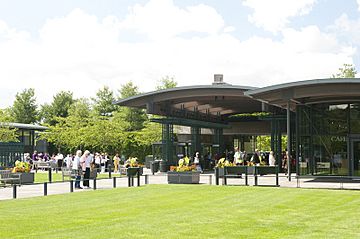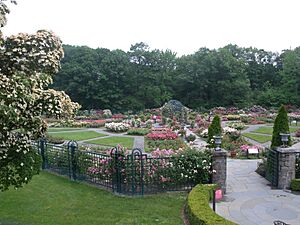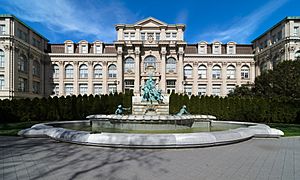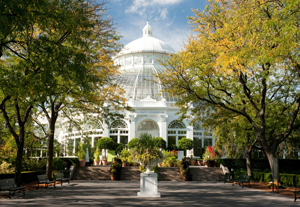New York Botanical Garden facts for kids
 |
|

Visitor Center in June 2012
|
|
| Established | 1891 |
|---|---|
| Location | The Bronx, New York City |
| Public transit access | Metro-North Railroad:
Harlem Line
Botanical GardenNew York City Subway: New York City Bus: Bx12, Bx12 SBS, Bx19, Bx22, Bx26 |
The New York Botanical Garden (NYBG) is a super cool place in Bronx Park, the Bronx, New York City. It's like a giant outdoor museum for plants! This amazing garden started way back in 1891. It covers 250 acres and is home to over a million living plants.
At NYBG, you can explore the Enid A. Haupt Conservatory, which is a huge greenhouse with many different plant habitats. There's also the LuEsther T. Mertz Library, which has one of the biggest collections of books about plants in the world. In 2016, more than a million people visited the garden.
NYBG is also a big school! It teaches people about plant science, how nature works, and even healthy eating. Many kids from nearby communities visit each year. Teachers from New York City schools also come to learn how to teach science better. NYBG runs one of the world's largest programs for studying and protecting plants.
Since 1967, the garden has been a National Historic Landmark. This means it's a very important historical place. Some of its buildings are also special New York City landmarks. The New York Botanical Garden helps us understand and care for the plant world. It's a museum of living plants, a school for plant science, and a center for important research.
Contents
How the Garden Started
Early Ideas for a Plant Paradise
People in New York City first thought about creating a botanical garden in 1877. They couldn't get enough money then, but they did set aside land for a future garden. By 1888, a group called the Torrey Botanical Society really pushed for a big botanical garden.
The idea for the garden came from Nathaniel Lord Britton, a plant scientist from Columbia University, and his wife, Elizabeth Gertrude Britton. They were inspired by the amazing Royal Botanic Gardens in London.
Finding a Home in the Bronx
In 1889, the Torrey Botanical Society decided to build the garden in Bronx Park. This park is in the middle of the Bronx, the northern part of New York City. Much of the land belonged to the Lorillard family. The city had already planned to get this land as part of the 1884 New Parks Act. This law aimed to save natural areas that would soon become part of the growing city. The City of New York bought about 640 acres around the Lorillard estate for Bronx Park between 1888 and 1889.
The Garden is Born
The New York Botanical Garden officially started on April 28, 1891, thanks to a law from the New York State Legislature. The garden used parts of the Lorillard estate and some land from St. John's College (now Fordham University). Some graves from the college cemetery had to be moved.
The main goal of the garden was to:
- Collect and grow plants, flowers, shrubs, and trees.
- Help advance plant science and knowledge.
- Do new research on plants and related topics.
- Teach people about plants and gardening.
- Show off beautiful gardens and plants.
- Provide fun, relaxation, and learning for everyone.
A group of directors was set up to run the NYBG. Important leaders and wealthy people like Cornelius Vanderbilt II, Andrew Carnegie, and J.P. Morgan helped raise money. Nathaniel Lord Britton became the new secretary. They promised to match the city's money to build the garden.
By 1895, enough money was raised. The directors asked landscape architect Calvert Vaux and his partner, Samuel Parsons Jr., to help choose the best spot. They picked the north end of Bronx Park. Vaux started planning, but he passed away soon after. A team of experts then created the final master plan for the garden.
The LuEsther T. Mertz Library and the Enid A. Haupt Conservatory were some of the first buildings. The Library was built from 1897 to 1900, and the Conservatory was finished in 1902.
Changes Over the Years (1900s to 1980s)
For many years, the NYBG didn't charge an entry fee. But in the 1950s, it started having money problems. In the 1970s, the city cut the garden's budget, forcing it to close several days a week. People worried it might close for good. In 1974, the garden had to ask the state for money every year.
The garden announced big plans to fix up the conservatory and add new plant displays. However, more budget cuts in 1975 meant the garden had to close on weekdays for the first time ever.
By the late 1980s and early 1990s, some parts of the NYBG looked a bit run down. There wasn't enough parking, and many areas were neglected. There was even a debate in 1994 when Fordham University wanted to build a tall radio tower near the Haupt Conservatory. This issue was finally solved in 2002.
New Beginnings (1990s to Today)
In the mid-1990s, the NYBG started making big changes to fix things up. In 1994, the garden began charging an admission fee. This money helped pay for improvements and keep the garden beautiful. The Everett Children's Garden opened in 1998, giving kids a special place to explore.
By 2000, the NYBG asked for $300 million for renovations, including a new gift shop and fixing up greenhouses and roads. A new visitor center and gift shop opened in 2004, costing $21 million. The library also got a new annex, which opened in 2002 as the International Plant Science Center.
The 2000s brought many new projects. The Leon Levy Visitor Center became the main entrance in 2004. The Nolen Greenhouses for Living Collections opened in 2005. The Plant Research Laboratory, where scientists study plants, opened in 2006. Many existing gardens were restored, like the Peggy Rockefeller Rose Garden (2007) and the Thain Family Forest (2011). New gardens were also added, such as the Home Gardening Center (2005) and the Native Plant Garden (2013).
In 2010, NYBG opened an education center in Manhattan. A new parking garage and entrance opened in 2012. The old Lorillard Snuff Mill was restored in 2010 and renamed the Lillian and Amy Goldman Stone Mill. In 2014, the Humanities Research Institute started, helping people think about how humans connect with nature. A new restaurant, the Hudson Garden Grill, opened in 2015. The Edible Academy, a place to teach kids and families about growing food and healthy eating, opened in 2018. In 2020, NYBG announced plans to partner on building affordable apartments nearby. In January 2024, the NYBG updated its look with a new logo and colors.
Exploring the Garden Grounds
The New York Botanical Garden has 50 different gardens and plant collections. You can find a peaceful waterfall, wetlands, and a 50-acre section of old-growth forest. This forest has never been cut down and is like a peek into what New York looked like long ago.
Some special spots include:
- The 1890s Haupt Conservatory, a beautiful glasshouse.
- The Peggy Rockefeller Rose Garden, first designed in 1916.
- An alpine rock garden, created in the 1930s.
- An Herb Garden, full of useful and fragrant plants.
- A 37-acre collection of conifer trees.
The NYBG also has amazing research facilities. These include a place to grow new plants, a library with 550,000 books, and an herbarium with millions of dried plant specimens. This herbarium is one of the biggest in the world!
Special Gardens and Plant Collections
At the heart of the Garden is the Thain Family Forest. This is a very old forest, the largest piece left of the original forest that covered New York City before European settlers arrived. It has oak, American beech, cherry, birch, tulip, and white ash trees, some over 200 years old!
The Bronx River, the only freshwater river in New York City, flows through this forest. You can see a river canyon and rapids. Along the river is the Stone Mill, which was built in 1840 and used to be called the Lorillard Snuff Mill. You can also find the Fountain of Life sculpture, created in 1905.
The Ladies' Border, a beautiful sheltered garden, was designed in the 1920s and installed between 1931 and 1933. It's near the Haupt Conservatory. The Jane Watson Irwin Perennial Garden has also been redesigned several times to keep it fresh and lovely.
Cool Buildings and Structures
Plant Research Laboratories
The Pfizer Plant Research Laboratory is a two-story building that opened in 2006. Here, scientists study plant genomics (plant DNA), how plants are related, how people use plants in New York City, and how plants make special chemicals. The lab has advanced equipment, including robots, to study plant DNA. They collect DNA from many different plant species to create a huge library of plant DNA. This collection is stored in freezers, holding millions of specimens, including rare or even extinct plants.
LuEsther T. Mertz Library
The LuEsther T. Mertz Library, named after a generous supporter, opened in 1899. It's in the northern part of the NYBG. This library has one of the world's largest collections of books and journals about plants. In 2014, it had 550,000 books and 1,800 different journal titles. The library building itself is very old and beautiful. It was designed in a Renaissance Revival style and finished in 1900.
Enid A. Haupt Conservatory
The Enid A. Haupt Conservatory, named after Enid A. Haupt, is a huge greenhouse at the western end of the NYBG. It was designed by a famous greenhouse company, Lord and Burnham Co., and finished in 1902. The design was inspired by other famous glasshouses like the Palm House in London's Royal Botanic Garden.
Inside the conservatory, you'll find many different kinds of plants. There are tropical plants and flowers, cacti and other desert plants, and even plants from rainforests. In the summer, the pools next to the conservatory are filled with beautiful lotuses and water lilies.
William & Lynda Steere Herbarium
The William & Lynda Steere Herbarium is located in the International Plant Science Center, behind the library. It's one of the biggest herbaria (collections of dried plant specimens) in the world, with about 7.9 million specimens! It started in 1891 and quickly grew by adding collections from other universities. The herbarium is named after William Steere and his wife Lynda, who supported it in 2002. Scientists use these specimens to study plant history and diversity.
Fun Programs and Exhibitions
Learning About Trees and Plants
In 2008, the NYBG started a project called TreeBOL (Tree Barcode of Life). With money from the Alfred P. Sloan Foundation, they are collecting DNA samples from up to 100,000 different tree species worldwide. This helps them understand the huge variety of plant life and create a "barcode" for each plant's DNA.
The NYBG also has a team of 200 staff members who train 42 students studying for their doctorates. Since the 1890s, NYBG scientists have gone on about 2,000 trips around the world to collect plants in the wild.
School of Professional Horticulture
In 1932, Thomas H. Everett created a special school to train expert gardeners. This school, now called the School of Professional Horticulture, teaches students for two years. They learn in classrooms and get hands-on experience in the gardens. It's like similar programs at the Royal Botanic Gardens in London and Edinburgh. Many top gardeners for public and private gardens have graduated from this school.
Exciting Exhibitions
The New York Botanical Garden always has cool exhibitions for visitors.
- Since 1992, they've had the Holiday Train Show every year. It features model trains running through tiny New York landmarks made from natural materials.
- In 2002, they started The Orchid Show, an annual display of beautiful orchids with different themes each year.
- Since 2007, there's been an annual fall exhibition of kiku, which are Japanese chrysanthemums grown into amazing shapes.
The garden has also hosted many large, special exhibitions, including:
- Sculpture from the Museum of Modern Art (2002)
- Chihuly at The New York Botanical Garden (2006, 2017)
- Darwin's Garden: An Evolutionary Adventure (2008)
- Monet's Garden (2012)
- Frida Kahlo: Art, Garden, Life (2015)
- KUSAMA: Cosmic Nature (2021)
Leaders of the Garden
Here are some of the people who have led the New York Botanical Garden over the years:
- Dr. Nathaniel Lord Britton (1891–1929)
- Elmer D. Merrill (1930–1935)
- Dr. Marshall A. Howe (1935–1936)
- Dr. Henry A. Gleason (acting, 1937–1938)
- Dr. William J. Robbins (1938–1958)
- Dr. William C. Steere (1958–1972)
- Dr. Howard S. Irwin (1973–1979)
- James M. Hester (1980–1989)
- Gregory Long (1989–2018)
- Dr. Carrie Rebora Barratt (2018–2020)
- Jennifer Bernstein (2021–Present)
Special Landmark Status
The New York Botanical Garden was named a National Historic Landmark in 1967. This means it's recognized as a place of great historical importance to the United States.
Also, three buildings within the garden are special New York City landmarks:
- The Enid A. Haupt Conservatory (named a landmark in 1973)
- The LuEsther T. Mertz Library (named a landmark in 2009)
- The Lorillard Snuff Mill (named a landmark in 1966, and also on the National Register of Historic Places)
See also
 In Spanish: Jardín Botánico de Nueva York para niños
In Spanish: Jardín Botánico de Nueva York para niños
- Education in New York City
- List of herbaria in North America
- List of botanical gardens and arboretums in New York
- List of museums and cultural institutions in New York City
- List of National Historic Landmarks in New York City
- National Register of Historic Places listings in Bronx County, New York
- Other botanical gardens in New York City





